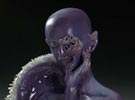Virtual, or Real?
——“Visual Viewing” of Liu Zhiyi’s “Encyclopedia of the Emperor”
Hang Chunxiao
Successfully changing the real experience of a college education into a digital experience is a special point of 1970s’ artist Liu Zhiyi. Because of this, his painting gives us a different sense of illusion: building real “senses” in a virtual world. Here, “sense” is not referred to a vision biologically, but a historical “viewing” and “expressing”, that is, a method relating to space, structure, volume, color and brushwork formed in the visual experiences of art history. Without doubt, Liu Zhiyi learned this from his education at Central Academy of Fine Arts and has a firm handle over this in the creation of his paintings. Take for example the “Encyclopedia of the Emperor” series created in 2005. Although these works describe the virtual world, the visual language is “precise” and shows a strong sense of “reality” in spatial expression. As a result, Liu Zhiyi uses a “harsh” realistic method to create a visual deception: the “virtual” of image narration and the “real” of visual representation consist of a kind of sensory paradox.
Paradox always brings “chaos”. But the question is—the world is not as logical as we experience it in our daily life, therefore there is always a certain “depth” in paradox. I am not certain why Liu Zhiyi chose to create a visual paradox. Is it because of his academic background or the result of his love of science fiction and digital things? As an individual living in the same era as him, I could feel the “viewing world” suspicion through this kind of visual paradox. That is, a suspicion, denial and asking of “cognition” as we usually know it by. Just like the real visual details in his paintings, the realistic state is virtualized and the virtual becomes real. Hence, Liu Zhiyi’s paintings present an illusory uncertainty.
We could say that this visual uncertainty is the difference in the expression of definite, direct and conceptual conception between the artists of Liu Zhiyi’s generation from the last. Artists of this generation are evolving with the rapid growth of China, but “rapid” brings to them a notion of “idealism” — discarding the old and establishing the new. Not only are there the exams affiliated to their personal lives and the changes of employment systems, but there is also the context of ideology and politics in a public domain and the subversion of discourse as well as the fast changing pace of economic reality. The result of this “change” is that there is doubt cast on the given conception such as value, meaning, etc. They try their best to seek their own rational examination through cynicism, by not accepting the definite answer of “slogans” any longer. Thus, this generation would not take a stand for “revolution” or “anti-revolution”. Therefore, unlike their predecessors, they no longer take part in voting various social issues. Instead they turn their focus to the dialogues of the “internal world” and make an attempt to gain constructive achievements from it rather than paying attention to social issues to seek value judgment.
Liu Zhiyi calls his creations “Encyclopedia of the Emperor”, which is a presentation of this “attempt”. “Empire”, as a conception of politics and history, is replaced in the contemporary context of “the Matrix” and “Cartoon Games” and causes semantic confusion to a degree. He attempts to disclose his own meaning of “empire” through this “confusion”—bringing awareness to issues of technology, the future, religions, etc. Without question, it is another empire— a rational and spiritual world which originated from individual examination. In the “Empire”, Liu Zhiyi makes an attempt to create a collection of systematic knowledge like the Encyclopedia. Encyclopedia is an important cultural phenomenon of rationalism and scientism represented by Denis in “Enlightenment”. Without a doubt, Liu Zhiyi’s usage of this conception displays his “ambition”— facing the uncertainty of the external world through rational consideration. As a result, Liu Zhiyi concludes the spiritual conversion from “suspicious” to “rational” and “internal” to “external” of the artists in 1970s.
Ultimately, his paintings bring this spiritual conversion into effect— full of uncertain illusions, creating his own image between the virtual and the real paradox. Moreover, Liu Zhiyi borrows his academic reality to describe reality, but he doesn’t utilize it directly by converting it through his well versed 3D technology. Compared to other individuals his age, he is extremely fascinated with the visual sensation of computer imaging. He always uses his imagination to create digital images on the computer through 3D technology. Then he faces the visual details of the screen and uses his sense of realism to make that conversion. This was unique for the artists of the 1970s. Perhaps, just because of this uniqueness, Liu Zhiyi’s works are considered a special “visual viewing”— the sentient world changed by “the robot’s eye”.
His visual presentation is no longer a “natural perspective” of realistic technology, but a “subjective perspective” with digital effects. These alterations are shown on his paintings as the following: focused volume is converted into plane reading volume; partial description of space is combined with overall description of collage; thickness and detail changes of color is integrated into a visual malleability. Depending on his rich experiences of screen and digital, his works show a new visual coding. This change of coding not only realizes the language conversion of easel painting, but also realizes the change of visual viewing — using new visual coding to show our new experience to viewing world. In the arts, this seems to have much more significance and value rather than new visual images. It gives us a sense of real enthusiasm which differs from classical art: art is no longer a simple vector in reproducing a kind of “nature” or “concept.” It prompts us to rethink the world’s “visual means” and needing us to abide by the cognitive means of virtual existence.
However, as an appreciator, I couldn’t tell whether the creator’s premeditation is consistent with my judgment or not. I couldn’t make a judgment of the feeling presented on Liu Zhiyi’s works above as an intentional enactment or some accidental choice of experience and interest, but it seems unimportant. The writings in art history pays more attention to the historical background of art phenomenon and its’ history of logic, including the evolution of concepts rather than the artist’s subjective opinion. I hope to find some commonalities based on his works in order to have a better understanding of the phenomenon taking place right now. Liu Zhiyi’s works clearly delivers this possibility to us, that is, his subjective experience between reality and virtuality. It gives us a valuable viewing experience — a feeling of living in the 1970s along with the digital logic and the linguistic conversion of easel paintings….
March 6th, 2011




